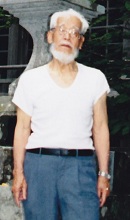


…………………………………………………………………………………………
[Note]
Only few of us know about the name of ‘Seki Hassou-Gumi’ (Group of Eight Boats from Seki) and its group structure. Important to record the historical details for the next younger generation.
Yamada Yasuke, the founder and the first boss senior leader boatman originally organized ‘Seki Hassou-Gumi’. He then shut down ‘Seki Hassou-Gumi’ and, expanding the scale of the group, newly organized ‘Bakan-Gumi’ (Group of Bakan). Yasuke’s younger brother, Yamada Matsuzo was successively promoted to the boss boatman. He developed ‘Rokuro-Se’, new rich fishery area located in front of Ashiya, northern Kyushu and realized and brought about big prosperity.
Yamada Matsuzo was the grand farther of Yamada Shigetoshi and he was as well his foster parent.
Most of the boats in ‘Bakan-Gumi’ were operated by four oars, and were each manned by 5~6 rowers. Each boat had a boatman and every 4 boats were controlled by a group chief boatman. On top of the group there was a boss senior leader boatman. In other explanatory words, there were squad leaders and, on top of them, there was a battalion commander (a boss senior leader boatman).
The boss boatman’s tasks were to negotiate fish price and to conclude contract of the fishery area. Sometimes, giving up his fishing for day after day, he had to visit the court to protect the whole group’s family and their lives, thus to fulfil the very important responsibility. The boss boatman was, therefore, a man of diplomatic skill and popularity.
In those days, as there were no cargo boats, they had to transport the caught fish by the following method.
They put together the whole caught fish among the four boats in one boat, which transported the fish to the markets in the ports of Wakamatsu and/or Shimonoseki. The transportation boat was changed one after another. The remaining three boats continued fishing in the fishery area until the Kanpu (Shimonoseki-Pusan) Ferry Boats stopped service because of the typhoons.
Sometimes, fishing boats were wrecked because of unreasonable control and management.
Yamada Matsuzo always worried about the accident and emphasized that “Life should come first. Abandon fishing implements and return to the port quickly in the dangerous situation. Any fishing implements would be purchased again only when you are alive. Never throw away your life.”
The ancestors invented the wisdom of such wonderful fish transportation method, which intensively promoted the spirit of one in body and mind and the group unification.
When they visited and went into the fish markets, they were to receive 2 tickets, by which they could exchange for 2 bottles of 1.8 litter of sake (rice wine) or 2 bidons of cakes.
Yamada Jinkichi (father of Yamada Shigetoshi), all at first, exchanged for cakes and put them under his control. Even when the others wanted to exchange for sake, they could not compete with the opponent, the son of the boss boatman.
An episode was told among the people of ‘Bakan-Gumi’, saying that Jinkich and his younger brother, Naojiro were always rejected to visit by the ‘zenzai’ (sweet soup made of red beans) restaurants. In those days ‘zennzai’ restaurants put up free of charge advertisement if the visitors were successful in eating more than certain limit of ‘zenzai’. The two brothers at any time ate until they reached the free of charge level.
Jinkichi did not drink sake. He, however, loved eating lots of cakes and finally died at the age of 37 years old because of stomach cancer, when Shigetoshi was 4 years and 7 months old.